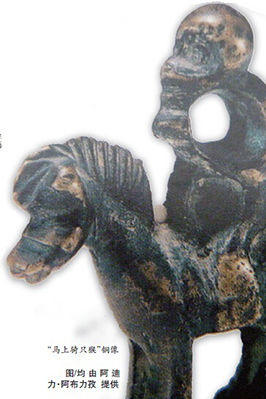Dozens of monkey artifacts have been unearthed in Xinjiang
At the moment, the Spring Festival greetings such as "The Year of the Monkey" and "Golden Monkey Announcement" are popular in the circle of friends, but compared with the blessings of the "immediately sealed Hou" and "generational generations" used by the ancients thousands of years ago, it has become Floating clouds." The reporter learned from the Xinjiang Uygur Autonomous Region Museum that since the monkeys were lively and clever, they have been loved by Xinjiang residents since ancient times. According to preliminary statistics, as of now, dozens of cultural relics have been unearthed in Xinjiang, and the materials are ceramic, copper, mud, stone, jade and other types, ranging from a few hundred years to two thousand years. Among them, the bronze statue of “Immediate Riding Monkey†unearthed in Mulei County of Xinjiang and the jade carving of the “generational generation of Houhou†unearthed in the Hetian area are most famous. "Immediately riding a monkey" means "immediately closing the Hou". The bronze statue is about 10 centimeters high. The horse and monkey on the horse are vivid, the horse is leisurely and quiet, the monkey is cute and cute, and there is a round hole above the bronze statue. Archaeologists believe that the cultural relics are about two thousand years old. "The generations of Hou Hou" is a Qing Dynasty jade relic. The cultural relics are carved with Hetian Baiyu. A mother monkey sits sideways and twists her head to the front. She rides two seemingly playful monkeys. The jade carving craftsmanship is unique. The tools are used to engrave several inscriptions on the forehead of the mother and the monkey to show the hair. The color of the cultural relics is unique. There are two colors of green and red. The red color is on the back of the monkey, and the cyan is distributed in the big. The monkey's waist, elbows and the face of a monkey look so subtle. In addition, the Sui Dynasty’s sacred monkeys and horse-cutting papers unearthed from the Astana tomb in the Turpan area of ​​Xinjiang are representative works of early Chinese paper-cutting; a group of Tang dynasty Taobao monkeys unearthed at the Jotgan site in Hetian area, some Blowing and smashing, some drumming, and some impeachment, are full of fun, and can not help but show the ancient love of music. A statue of a stone monkey from the Tang Dynasty unearthed in the Hami area. The monkey is squatting on a square stone with a large bowl on the head, depicting the scene of the street performers playing the monkeys in the Tang Dynasty; the Southern and Northern Dynasties clay monkeys unearthed from the Tokuyu Salai site in the Kashgar region. The servant's unique shape, the monkey head, the hand-held scepter, the image is weird, the archaeologists analyzed that it may be a certain monster action of the Buddhist theme, and some people think that it is the image of the king. The researchers of the Xinjiang Uygur Autonomous Region Museum believe that the worship of the Hou is the value orientation of the ancients. The "monkey" is a symbol of the good things of Ji Rui, so the "monkey" is made into various ornaments, accessories, etc. blessing. Mesh Embroider Fabric,Lace Mesh Fabric,Embroidered Mesh Fabric,Mesh 3D Embroidered Fabric Shaoxing Chengao Textile Co.,Ltd , https://www.chengaotextile.com